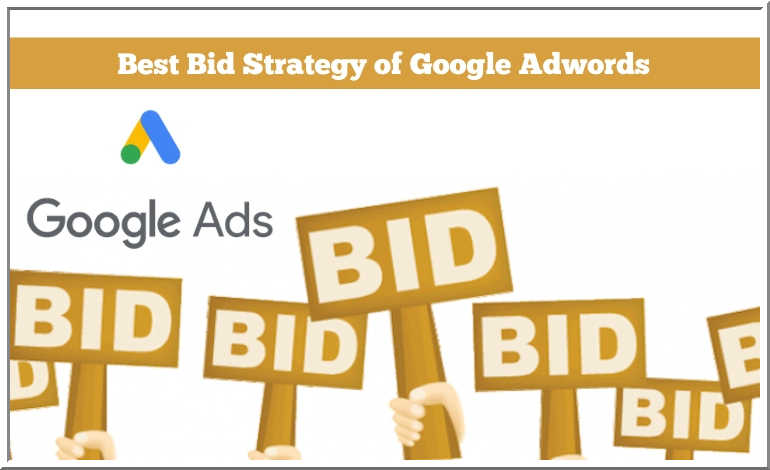
Know All about Bid Strategy of Google Adwords you Don’t Know
Google Adwords bidding draws a huge number of bidders. It is one of the proven methods of optimizing PPC advertising. What are these bids? Before we move into the strategy of bidding Google Adwords, let’s first look at the different types of Adwords bidding Google offers to the advertisers and then the best strategy to use them. When you kick-start a new campaign on Google Adwords, you will be prompted to choose either automated bidding or manual bidding. Which bid strategy is better for you? It depends on your business type and preferences.
Table of Content
Strategy 1: Automated or Manual bidding?
- Automated bidding relies on volume. There has to be a minimum of 30 conversions in the past 30 days for automated strategies. Automated bidding is not ideal for accounts with less activity. It can sometimes lead to a significant rise in the cost spent on ads and needs a flexible budget to accommodate the spending.
- Manual bidding allows you some degree of charge to adapt quickly to the changes in the bidding.
- With manual bidding, you can put in your own cost-per-click.
- Manual bidding needs monitoring of bids; however, they come with a flexibility that is an advantage for most businesses.
- Most manual bidders use tiered bidding, which means different bids for different keywords. This is a strategy used widely by PPC advertising experts.
Thus, automated bidding is efficient for businesses that have the large volume as the Google algorithms can then arrive at the most optimum bit price.
Strategy 2: What Are the Different Types of Automated Smart Bidding Options You Have for Conversion Focused Ad Campaign?
- Target Cost Per Acquisition (CPA): This will primarily focus on trying to get conversions at a specific acquisition cost. The bids are automatically set on each campaign. You need to have a thorough knowledge of the acquisition costs.
- Target Return on Ad Spend (ROAS): Google will set the bids to optimize the value return you desire from your ad spend. The target return on ad spend is calculated in percentage. Ad Spend is multiplied by 100% and then divided by the sales. The result is your Target ROAS.
- Maximize Conversions: You can set an upper limit to the daily budget for bids. Google will derive the optimum bid accordingly.
- Enhanced Cost per Click (CPC): Google can automatically decrease your bid with this one and minimize the costs as per your CPC settings.
You can opt for any of the following depending on whether your campaign objective is conversions, impression or clicks. If you want direct action, then opt for conversion-focused smart bidding. CPC is used when you want to drive traffic to your website. Similarly, a CPM strategy can be used if you have video content.
Strategy 3: When to Use CPC Bidding?
- Automated CPC Bidding: CPC bidding is focused more on getting traffic to your website. If you have a budget that needs consistency and you don’t have the time and resources to monitor bids, then CPC bids are ideal. This strategy can be used by businesses that are new to Adwords Bidding.
- Manual CPC Bidding: If you have your keywords ready then you can opt for a manual CPC. You have the flexibility to control the maximum bids for each keyword and you don’t need to set a target budget as in the case of automated bidding.
Strategy 4: What Should Be Your Bid Strategy If You Are Focusing on Impressions?
These bids will optimize your visibility or impressions:
- Target Search Page Location: Google will automatically raise or lower your bids in order to show your ads on the top of search page results. The bidding strategy tries to place the ads in the targeted location but doesn’t guarantee any place as the final result is variable dependent on the auction. It can be applied to an active campaign.
- Target Outranking Share: This bid is placed for the competitive domains trying to outbid the rival domains. Often, the ad will be displayed above the targeted domain. Alternatively, your business can do an audit of the auction insights report and find out about the competitive domains that participate in AdWords auction bids.
- Cost-Per-Thousand-Impressions: Effective for videos, you will pay only for the number of times your ad has been viewed.
- Viewable Cost-Per-Thousand Impressions (vCPM): You bid for per 1000 views. This kind of bidding strategy can be used when you want to increase brand awareness more than clicks and impressions. Most advertisers use these metrics/impressions to measure the effectiveness of display advertising.
Your bid strategy will vary greatly from others. What has worked for others may not work for you. Hence, bidding strategies should be devised by experts. With smart bidding, do you need manual bidding? Yes, because even with automated bidding, you will need to monitor and update your strategies. Caution must be taken before placing your business in the Adwords bid.
